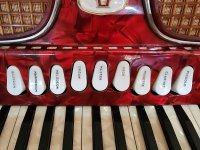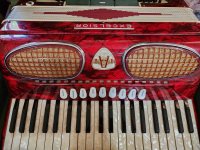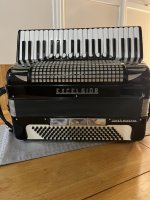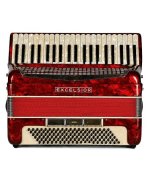You are using an out of date browser. It may not display this or other websites correctly.
You should upgrade or use an alternative browser.
You should upgrade or use an alternative browser.
Any info on this Excelsior, please?
- Thread starter Cjames
- Start date
To me it looks like this was originally an Accordiana by excelsior that someone put an Excelsior nameplate on. Accordiana was their lower tier brand that were good student to intermediate level instruments. They are often regarded as having higher build quality than other instruments in their category. Of course it’s possible that Excelsior marketed their brands differently in different markets, and possibly sold their entire range with one brand name instead of breaking it into 2 or 3 like they did for the US market.
I don’t know the specs of the 320 but looking at the registers it likely has 4 treble reed sets. Pulling the bellows pins to verify might be a good idea. As with any old accordion condition of the internal parts is the most important thing.
I don’t know the specs of the 320 but looking at the registers it likely has 4 treble reed sets. Pulling the bellows pins to verify might be a good idea. As with any old accordion condition of the internal parts is the most important thing.
Yep, looks a lot like an Accordiana by Excelsior:
That says
4/5 LMMH Reeds
41 treble keys with 9 registers (the possibilities are endless)
120 Bass Buttons 28th 3 registers
And I believe Reverb are fairly accurate (from the descriptions I've seen anyway).
That says
4/5 LMMH Reeds
41 treble keys with 9 registers (the possibilities are endless)
120 Bass Buttons 28th 3 registers
And I believe Reverb are fairly accurate (from the descriptions I've seen anyway).
Thank you, yes, the nameplate confused me, somewhat.To me it looks like this was originally an Accordiana by excelsior that someone put an Excelsior nameplate on. Accordiana was their lower tier brand that were good student to intermediate level instruments. They are often regarded as having higher build quality than other instruments in their category. Of course it’s possible that Excelsior marketed their brands differently in different markets, and possibly sold their entire range with one brand name instead of breaking it into 2 or 3 like they did for the US market.
I don’t know the specs of the 320 but looking at the registers it likely has 4 treble reed sets. Pulling the bellows pins to verify might be a good idea. As with any old accordion condition of the internal parts is the most important thing.
To me it looks like this was originally an Accordiana by excelsior that someone put an Excelsior nameplate on. Accordiana was their lower tier brand that were good student to intermediate level instruments. They are often regarded as having higher build quality than other instruments in their category. Of course it’s possible that Excelsior marketed their brands differently in different markets, and possibly sold their entire range with one brand name instead of breaking it into 2 or 3 like they did for the US market.
I don’t know the specs of the 320 but looking at the registers it likely has 4 treble reed sets. Pulling the bellows pins to verify might be a good idea. As with any old accordion condition of the internal parts is the most important thing.
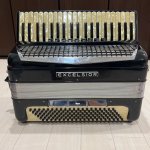 Oddly, here's another Model 320 with a similar nameplate.
Oddly, here's another Model 320 with a similar nameplate.Jules Martin
Newbie
That's a slightly different name plate. The one in question has a solid rectangular name plate. And this model is the 'Super Musette'.
Jules Martin
Newbie
Sorry I was referring to the part in the original post that said "The labels on the back are 'model 320', 'made in Italy', and 'product of Excelsior'."That's a slightly different name plate. The one in question has a solid rectangular name plate. And this model is the 'Super Musette'.
When I see something like this, it screams "not original to the accordion", so chances are pretty fair that it could be mislabeled, it's not a guarantee of that, but a pretty good chance.
I used to play in an accordion orchestra where fully 75% were Excelsiors, I saw many of these (not supermusette, though). They were mid-range boxes, sounded good, were reliable and even new, pretty fairly priced.
You'd think so, Jerry, but if you look at the red one on the first post, and the black one further down, they both have that name plate. It does look like a relabel, but maybe done by the factory.When I see something like this, it screams "not original to the accordion", so chances are pretty fair that it could be mislabeled, it's not a guarantee of that, but a pretty good chance.
We used to have someone intimately familiar with Excelsiors, I don't have that level of of comfort with them... but I will say that I never in real life saw a badge like this on any other Excelsiors other than the 2 that were shown here.You'd think so, Jerry, but if you look at the red one on the first post, and the black one further down, they both have that name plate. It does look like a relabel, but maybe done by the factory.
Just to ask... are those 2 accordions somehow related? Like both on reverb, or sold by the same person or from the same part of the country or something like that?
I ask becuase those are not factory quality badges... I could go to a mall and anywhere that they make door or desk badges and recreate those for $2-$5.
These accordions are unrelated. One is in Australia, and the other is somewhere else in the world. Intriguing!We used to have someone intimately familiar with Excelsiors, I don't have that level of of comfort with them... but I will say that I never in real life saw a badge like this on any other Excelsiors other than the 2 that were shown here.
Just to ask... are those 2 accordions somehow related? Like both on reverb, or sold by the same person or from the same part of the country or something like that?
I ask becuase those are not factory quality badges... I could go to a mall and anywhere that they make door or desk badges and recreate those for $2-$5.
Interesting.
To me after all the examples it looks like excelsior sold the same model with different brand names at different times and/or for different markets. Kind of how the 914 model car was sold in some markets as a Porsche and others as a Karmann. The first example has the A badge which is usually on Accordiana branded instrument and the grill design is also what is normally seen on Accordiana. What’s most important isn’t the brand name but the quality and the voicing of the reeds. I would expect the Accordiana version of that model to have standard factory reeds. They may or may not have upgraded to a higher grade of reeds when they built one with an excelsior logo on it, but I think it is more likely they didn’t. Best way to find out is pull the bellows pins and check it out.
That sounds a logical explanation. I own the first red one in this thread. I'm a newbie accordion player, so I can't discern a factory reed from a higher grade. What to look at? I've checked out the reed blocks and I'm thinking I'll replace all the valves, as there are a couple of fluttery ones in the lower register. To my untrained eyes and ears, it looks like a quality build, and sounds great! I certainly didn't pay very much for it.To me after all the examples it looks like excelsior sold the same model with different brand names at different times and/or for different markets. Kind of how the 914 model car was sold in some markets as a Porsche and others as a Karmann. The first example has the A badge which is usually on Accordiana branded instrument and the grill design is also what is normally seen on Accordiana. What’s most important isn’t the brand name but the quality and the voicing of the reeds. I would expect the Accordiana version of that model to have standard factory reeds. They may or may not have upgraded to a higher grade of reeds when they built one with an excelsior logo on it, but I think it is more likely they didn’t. Best way to find out is pull the bellows pins and check it out.
There are several threads that discuss how to identify different types of reeds. This was one I could find quickly. But there are others that might be easier to follow. Factory reeds usually sound fine but usually wont functional as evenly over different pressures and can be less efficient with air.
These are hand made reeds. Picture 5 is the clearest for this identification but 3 is also already good.
Machine reeds and tipo-a-mano (hand finished) reeds are stamped out of a wide band of steel that comes on large rolls. As a result the sides of the reeds are all "shiny" metal. A mano (hand made) reeds are made from a narrow band of steel that also comes on large rolls. The band has the same width as the square base of the reed (where the rivet is). The band of steel has blue edges. By shaping the reeds the sides lose that blue, but the base isn't touched and thus keeps its blue edges...
Machine reeds and tipo-a-mano (hand finished) reeds are stamped out of a wide band of steel that comes on large rolls. As a result the sides of the reeds are all "shiny" metal. A mano (hand made) reeds are made from a narrow band of steel that also comes on large rolls. The band has the same width as the square base of the reed (where the rivet is). The band of steel has blue edges. By shaping the reeds the sides lose that blue, but the base isn't touched and thus keeps its blue edges...
Thanks very much!There are several threads that discuss how to identify different types of reeds. This was one I could find quickly. But there are others that might be easier to follow. Factory reeds usually sound fine but usually wont functional as evenly over different pressures and can be less efficient with air.
These are hand made reeds. Picture 5 is the clearest for this identification but 3 is also already good.
Machine reeds and tipo-a-mano (hand finished) reeds are stamped out of a wide band of steel that comes on large rolls. As a result the sides of the reeds are all "shiny" metal. A mano (hand made) reeds are made from a narrow band of steel that also comes on large rolls. The band has the same width as the square base of the reed (where the rivet is). The band of steel has blue edges. By shaping the reeds the sides lose that blue, but the base isn't touched and thus keeps its blue edges...


